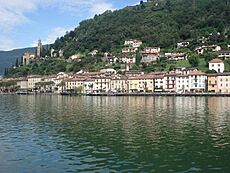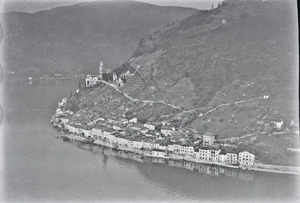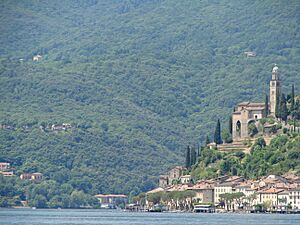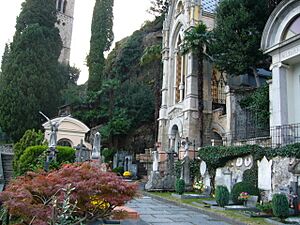Morcote facts for kids
Quick facts for kids
Morcote
|
|
|---|---|
 |
|
| Country | Switzerland |
| Canton | Ticino |
| District | Lugano |
| Area | |
| • Total | 2.79 km2 (1.08 sq mi) |
| Elevation | 272 m (892 ft) |
| Population
(Dec 2020 )
|
|
| • Total | 734 |
| • Density | 263.1/km2 (681.4/sq mi) |
| Postal code |
6922
|
| Surrounded by | Brusimpiano (IT-VA), Brusino Arsizio, Lugano, Porto Ceresio (IT-VA), Vico Morcote |
| Twin towns | Viarmes (France) |
Morcote is a beautiful town in Switzerland. It's located in the canton of Ticino, about 10 kilometers from Lugano. Morcote sits right on the shore of Lake Lugano.
Contents
History of Morcote
Morcote was first mentioned in history in the year 926. Its name, Murcau, comes from the Latin words Morae caput, which means "head of the hill."
Around the year 1100, a castle was built in Morcote. This castle helped guard and control trade on the lake. Before a dam was built in Melide in 1847, Morcote was the biggest port on Lake Lugano. Goods from northern Italy were shipped across the lake to other parts of Ticino.
In 1422, the town received special rights from the Duke of Milan. These rights allowed Morcote to collect taxes, govern itself, fish independently, and hold markets. After a terrible sickness called the plague in 1432, only seven families were left in the town.
Morcote was often caught between the powerful cities of Milan and Como. In 1517, the area became part of the Old Swiss Confederation. Even then, Morcote kept many of its special rights. These included making its own laws, collecting taxes, and having fishing rights over the entire lake.
During the Late Middle Ages, the main jobs in Morcote were fishing, farming, and shipping. Later, artists also started to move to the town. In 1583, the town got its own church, Santa Maria del Sasso, which had been built in the 13th century.
Sadly, in 1862, seven houses in Morcote slid into the lake.
In the 19th century, tourism became a very important business in Morcote. More recently, making wine and handicrafts have also become popular activities.
Morcote's Geography
Morcote covers an area of about 2.8 square kilometers. A small part of this land (2.5%) is used for farming. Most of the area (81.5%) is covered by forests. The rest (16.0%) has buildings or roads.
About 13.3% of the total area is covered only with buildings. This has increased over the years. Some land is also used for fun activities like parks. For farming, there are vineyards, fields, and areas for animals to graze.
Even though Morcote is on the lake, the town's official borders don't include any rivers or large parts of the lake itself.
The town is located in the Lugano area, between Lake Lugano and a mountain called Monte Arbostora. Morcote includes the main village and used to include other small villages like Vico and Carabietta.
Morcote's Coat of Arms
A coat of arms is like a special symbol for a town or family. Morcote's coat of arms shows two main parts. The top part has a red background and shows a shepherdess sitting on a bundle of hay, all in silver. The bottom part has a green background and shows a mother pig with her piglets, also in silver.
Important Heritage Sites
Morcote has several places that are considered very important national heritage sites. These include the Chapel of S. Antonio Abate with its grand staircase, the Parish Church of S. Maria del Sasso, the old Cemetery, and Scherrer Park. The entire village of Morcote is also recognized as an important Swiss heritage site.
Santa Maria del Sasso Church
The church of Santa Maria del Sasso was likely built in the 1200s. It was rebuilt in 1462 in the Renaissance style. Later, in 1758, it was updated in the Baroque style. In the 1700s, a huge staircase was added to the front. The church tower is very old, from the Middle Ages, and was made taller in the 1500s. Inside, you can see beautiful old paintings called frescos from the 1500s and 1600s.
Sant'Antonio da Padova Chapel
Near the church is the Chapel Sant'Antonio da Padova. It was built in 1676 and has an interesting eight-sided shape with a dome.
Morcote Cemetery
A large cemetery was added near the church in 1750. This cemetery is built on terraces overlooking the lake. Many famous artists are buried here. These include Alexander Moissi (an actor), Georges Baklanoff (a Russian singer), Georg Kaiser (a German writer), and Eugen d’Albert (a German composer and pianist).
Sant'Antonio Abate Chapel
The chapel of Sant'Antonio Abate was blessed before 1591. It used to be a place where travelers could stay, run by a group called the Antonines. Inside, it has old paintings from the 1400s and other newer artworks.
Palazzo Paleari and Lake Arcades
The covered walkways (arcades) along the lake shore are very old, some from the Late Middle Ages. They include several fancy houses built between the 1500s and 1700s. One of the most interesting is the Palazzo Paleari, built in 1483 and updated in 1661.
Scherrer Gardens
In 1965, the Scherrer Gardens were opened to the public. This used to be the home of a rich textile merchant. The gardens are full of beautiful plants from warm places, like palm trees, camellias, and orange trees. They also have many interesting buildings and art pieces from all over the world.
Morcote's Population
Morcote has a population of about 755 people. As of 2016, about 42.3% of the people living in Morcote are from other countries. Many of them (about 20.7%) were born in Italy.
Most people in Morcote (about 70.2%) speak Italian. German is the second most common language (18.8%), followed by Serbo-Croatian (3.8%).
In 2008, about 47.5% of the population were men and 52.5% were women.
Morcote has an older population compared to the national average. In 2016, about 12.6% of the population were children and teenagers (0-19 years old). Adults (20-64 years old) made up 60.7%, and seniors (over 64 years old) made up 26.7%.
In 2016, there were 403 homes in Morcote, with about 1.84 people living in each home on average. Most of the buildings (about 66.6%) are single-family homes.
Notable People from Morcote
- Domenico Rossi (1657–1737): A Swiss-Italian architect.
- Davide Antonio Fossati (1708–1795): A painter and etcher.
Morcote's Economy
Morcote is known as a community with high incomes. It is part of the larger city area of Lugano.
In 2014, there were 239 jobs in Morcote. There were no jobs in farming or fishing (primary sector). The manufacturing sector (secondary sector) had 41 workers in seven businesses. The service sector (tertiary sector), which includes things like tourism and shops, had 198 jobs in 69 businesses.
In 2015, hotels in Morcote had over 3,000 overnight stays. About one-third of these visitors were from other countries.
Morcote is a place where more people come to work than leave for work. About 24.5% of the people who come to work in Morcote are from outside Switzerland. Most people (57.5%) use a private car to get to work, while 6.7% use public transportation.
Religion in Morcote
Based on a 2000 survey, about 73.6% of the people in Morcote were Roman Catholic. About 11.5% belonged to the Swiss Reformed Church. A small number of people belonged to other churches or did not state their religion.
Education in Morcote
In Morcote, about 74% of adults (aged 25–64) have completed higher education. This means they have gone beyond basic schooling, either to a university or a specialized college.
In 2009, there were 69 students in Morcote. The education system in Ticino offers up to three years of optional kindergarten. Morcote had 6 children in kindergarten.
Primary school lasts for five years. In Morcote, 17 students attended regular primary schools, and 2 attended a special school.
For middle school, students can choose between a two-year program followed by job training, or a four-year program to prepare for higher education. There were 16 students in the two-year program and 9 in the four-year program.
After middle school, students can prepare for a trade or for university. Some students attend school while doing an internship (vocational students). In Morcote, 11 students were full-time vocational students, and 5 were part-time. There were also 3 students in a professional program that prepares them for jobs in fields like engineering or nursing.
In 2000, 14 students living in Morcote went to school in other towns. Also, 52 students from other towns came to school in Morcote.
Images for kids
See also
 In Spanish: Morcote para niños
In Spanish: Morcote para niños










